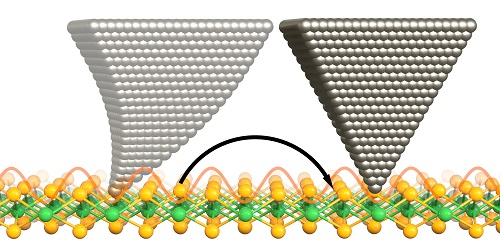Atomic Friction Defies Expectations
According to conventional models of friction, the frictional force between two solid surfaces sliding against each other is independent of the sliding velocity. But in the past few decades, experiments at the atomic scale have demonstrated that this frictional force can strengthen as the sliding velocity increases. Now Yiming Song at the University of Basel, Switzerland, and his colleagues have observed an even more intricate velocity dependence of atomic friction [1]. The researchers say that their work could help scientists design material interfaces with desired frictional properties.
Song and his colleagues grew a pristine layer of molybdenum disulfide on a gold substrate. They then slid the sharp tip of an atomic force microscope across this layer’s surface. Lastly, they measured the strength of the frictional force between the tip and the surface by observing the deflection of a flexible cantilever attached to the tip. For sliding velocities below 10 nm/s and above 100 nm/s, the frictional force strengthened as the velocity increased, akin to the previous experiments. But for velocities between those two values, the force unexpectedly weakened as the velocity increased.
Theoretical work and numerical simulations showed that, when the sliding velocity was below 10 nm/s, the microscope tip moved from one atomic-scale bump to the next on the molybdenum disulfide surface. As the velocity increased from 10 to 100 nm/s, the tip skipped over more and more bumps as it moved, weakening the frictional force. Finally, when the velocity exceeded 100 nm/s, this weakening effect ceased as the tip glided across the surface, unimpeded by the bumps. The team suggests that these findings could improve researchers’ understanding of large-scale sliding phenomena such as earthquakes and propagating cracks.
–Ryan Wilkinson
Ryan Wilkinson is a Corresponding Editor for Physics Magazine based in Durham, UK.
References
- Y. Song et al., “Nonmonotonic velocity dependence of atomic friction induced by multiple slips,” Phys. Rev. Lett. 133, 136201 (2024).




